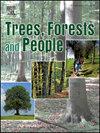刚果民主共和国卢基生物圈保护区景观中可食用毛虫寄主植物的多样性和可获得性
IF 2.7
Q1 FORESTRY
引用次数: 0
摘要
食用毛虫是非洲农村居民的重要食物和经济资源。然而,它们也面临着许多威胁,尤其是其寄主植物受到威胁。卢基生物圈保护区是刚果民主共和国的一个地区,食用毛毛虫的习俗是最近才出现的;但是,农村社区却报告说毛毛虫非常稀少。本研究评估了卢基生物圈保护区(LBR)景观中可食用毛虫寄主植物的多样性和可用性。在森林、受保护的稀树草原、休耕区和居住区的每个栖息地的 11 公顷地块上进行了植物调查,调查面积为 44 公顷。采用基于覆盖率的稀疏化和外推法以及 iNEXT 在线软件来计算食用毛虫寄主植物的真实多样性。通过计算每个直径等级中的个体数量,评估了食用毛虫寄主植物物种的直径结构。结果显示,在卢基生物圈保护区景观中,食用毛虫主要依赖 15 种寄主植物(Spondias mombin L.、Petersianthus macrocarpus (P.Beauv.) Liben、Croton sylvaticus Hochst、Celtis mildbraedii Engl., Coelocaryon botryoïdes Vermoesen, Albizia gummifera (J.F.Gmel.) C. A. Sm, Bridelia atroviridis Müll.Arg, Ficus mucuso Welw、C.C.Berg.)和 Terminalia superba Engl.& Diels)。这些生境中可食用毛虫寄主植物的物种多样性较低。此外,其中一些物种正变得稀少或在当地濒临灭绝。该研究结果表明,与人类活动相关的潜在栖息地不稳定性可能会导致生物多样性的丧失,进而导致LBR景观中可食用毛虫数量的减少。更好地了解影响可食用毛虫营养支持的不利条件将有助于推广适当的战略,这些战略可在景观尺度上应用于社区土地的地方发展计划中。本文章由计算机程序翻译,如有差异,请以英文原文为准。
Diversity and availability of edible caterpillar host plants in the Luki biosphere reserve landscape in the Democratic Republic of the Congo
Edible caterpillars are an important food and economic resource for rural African people. However, they are subject to a number of threats; in particular, their host plants are threatened. The Luki Biosphere Reserve landscape is a region of the Democratic Republic of Congo where the practice of eating caterpillars is a recent phenomenon; however, rural communities have reported their scarcity. This study assessed the diversity and availability of host plants of the edible caterpillars in the Luki Biosphere Reserve (LBR) landscape. Botanical inventories were conducted in eleven ha plots of each of the following habitats: forest, savannah under protection, fallow, and inhabited areas, covering an area of 44 ha. The coverage-based rarefaction and extrapolation method and the iNEXT online software were used to calculate the true diversity of edible caterpillar host plants. The diameter structure of the edible caterpillar host plant species was assessed by counting the number of individuals in each diameter class. The results revealed that in the Luki Biosphere Reserve landscape, edible caterpillars rely on 15 main plant host species (Spondias mombin L., Petersianthus macrocarpus (P.Beauv.) Liben, Croton sylvaticus Hochst. ex Krauss, Hymenocardia acida Tul., Lannea welwitschii (Hiern) Engl., Macaranga spinosa Müll.Arg., Celtis mildbraedii Engl., Coelocaryon botryoïdes Vermoesen, Albizia gummifera (J.F.Gmel.) C. A. Sm, Bridelia atroviridis Müll.Arg, Ficus mucuso Welw. ex Ficalho, Funtumia elastica (P.Preuss) Stapf, Lannea welwitschii (Hiern) Engl., Milicia excelsa (Welw.) C.C. Berg., and Terminalia superba Engl. & Diels). The habitats exhibited low species diversity of the edible caterpillar host plants. Moreover, several of these species are becoming scarce or are locally threatened with extinction. The trend in the diametric structure is similar to species evolving in a disturbed environment.The results of this study suggest potential habitat instability linked to human activities that could lead to biodiversity loss and, thus, a decline in edible caterpillars in the LBR landscape. A better understanding of the unfavourable conditions that influence the nutritional support for the edible caterpillars would help promote appropriate strategies that can be applied in local development plans for community lands at a landscape scale.
求助全文
通过发布文献求助,成功后即可免费获取论文全文。
去求助
来源期刊

Trees, Forests and People
Economics, Econometrics and Finance-Economics, Econometrics and Finance (miscellaneous)
CiteScore
4.30
自引率
7.40%
发文量
172
审稿时长
56 days
 求助内容:
求助内容: 应助结果提醒方式:
应助结果提醒方式:


